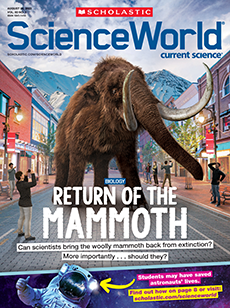ADRIEN LESAFFRE
MESSY EATER: This wolf’s muzzle is covered in pollen.
An Ethiopian wolf approaches a red hot poker plant. The wolf sniffs the plant’s cone-shaped flower, sticks its snout into the blossom, and licks up the sugary nectar. When scientists first spotted this behavior a few decades ago, they were surprised. They’d never seen a large meat-eating predator enjoy a sweet treat in this way. Recently, researchers from the University of Oxford in the United Kingdom observed something even more surprising. After drinking nectar, the wolves’ faces were covered in grains of pollen.
The scientists realized the wolves might be transferring pollen to other flowers they lick, acting as pollinators and helping the plants reproduce. This role is usually filled by small flying animals like birds, bees, or bats. “Who would have imagined that a wolf could pollinate flowers?” says Sandra Lai, a biologist who worked on the study. “This unique connection is something truly special.”
